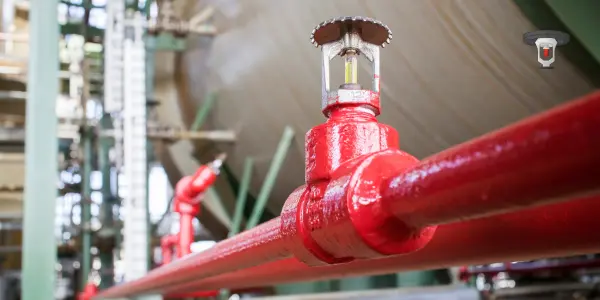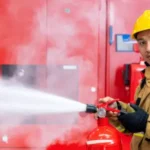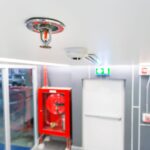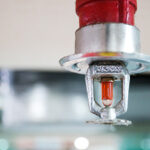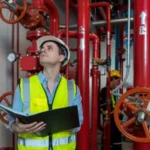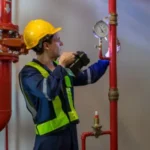When it comes to protecting buildings and occupants from fire, fire sprinkler systems are lifesavers. But here’s the catch! Not all sprinklers are the same. There are various types of fire sprinkler systems, and you have to choose the right one as per your needs. Depending on your building, what materials you have stored inside, and even the weather in your area, you may need a much different system than your friend’s office or warehouse down the street. Let’s break down the big picture of fire sprinkler systems so you can know what will work best for your space.
What is a Wet Pipe Sprinkler?
Consider a wet pipe sprinkler system, the “oldie but goodie” sprinkler. The pipes are continuously charged with water, standing by. As soon as a sprinkler head senses heat from a fire, water bursts out right away.
These types of systems are extremely reliable and require little upkeep. They function optimally in environments that don’t experience extreme cold—such as houses, offices, or stores. It is so because extremely cold temperatures have the potential to freeze the pipes, causing them to burst. Wet pipe sprinklers are simple, efficient, and likely the type most individuals envision upon hearing the term fire sprinkler system.
How Does a Dry Pipe Sprinkler System Work?
Now, suppose you have to install sprinklers in an area that is extremely cold, such as an unheated warehouse or a garage. That’s where dry pipe sprinkler systems are necessary.
In contrast to wet pipe systems, pipes are charged with air or nitrogen rather than water. When the temperature activates a sprinkler, pressure drops in the air, triggering a valve to open that allows water to pass through. It’s a smart solution to avoid freezing pipes, but it might take a couple of seconds longer for water to emerge than in wet pipe systems.
What Is a Pre-Action Sprinkler System?
Pre-action sprinkler system is a sort of a wet-dry hybrid—and they’re ideal for delicate areas such as data centers, museums, or archives.
Here’s how it works: The pipes are charged with air, similar to a dry system, but water only passes through if two events occur. One, a smoke or fire detector must be activated. Two, a sprinkler head must open.
This two-layered protection is where you have the fire suppression with no concern about accidental water damage to priceless equipment. Pre-action systems are more complicated, but where water damage is a huge issue, it’s a savior.
When Would You Use a Deluge Sprinkler System
A deluge sprinkler system is designed for high-hazard occupancies, where fires have the potential to spread rapidly, such as chemical plants or factories. Open heads are the main characteristic of these systems, and when activated, water fills all heads simultaneously.
This blanket approach keeps hazardous fires from getting out of hand. Deluge systems are typically connected to a fire detection system, so they activate immediately in the event of an issue.
What’s Unique About ESFR Sprinkler Systems?
ESFR is shorthand for Early Suppression, Fast Response—and yes, it delivers. These sprinklers are designed for modern warehouses with high racks of merchandise. Fires in such areas tend to spread rapidly, but ESFR sprinkler system is intended to extinguish flames before they can get away from responders.
They discharge water quickly and in greater volume than typical sprinklers, making them perfect for safeguarding individuals and stock in high-hazard warehousing conditions.
Why Warehouse Fire Sprinkler Systems Are So Vital
Warehouses commonly hold tons of flammable material piled high. That’s why warehouse fire sprinkler systems, such as ESFR or other wet and dry systems, are so vital.
These sprinklers don’t suppress fires—they control them, providing employees time to evacuate and avoiding extensive destruction of property. Installed and maintained correctly, sprinklers can save lives, prevent inventory loss, and minimize downtime from fire.
How Do You Select the Correct Sprinkler System?
Selecting the correct system has a great deal to do with several factors:
- Your building and the purpose it will serve: Offices, residences, warehouses, and factories each pose varying risks of fire.
- Temperature conditions: If your pipes may freeze, dry pipe or pre-action systems are the best option.
- Fire hazards: Flammable contents areas of high risk will require deluge or ESFR systems.
- Budget and maintenance: Some systems are more complicated and require more maintenance, so keep that in mind.
It’s always a good idea to have an insurer refer you to a certified fire protection professional—they will ensure you choose the system that’s safe, effective, and code-compliant.
Frequently Asked Questions (FAQs)
Q1: How do wet pipe and dry pipe sprinklers differ?
A: Wet pipe sprinklers contain water in pipes at all times and discharge it the moment they are activated. Dry pipe sprinklers operate on air pressure to exclude water from pipes until there is a fire, thus ideal for cold conditions.
Q2: Are pre-action sprinklers suitable for delicate equipment?
A: Yes. They discharge water only when a fire is sensed and a sprinkler head operates, limiting the potential for unintentional water damage.
Q3: How and when should a deluge sprinkler system be applied?
A: In situations where the risk of fire is high and can easily spread, such as in chemical plants, refineries, or factories.
Q4: How do ESFR sprinklers benefit warehouses?
A: They act fast with high water volume, extinguishing fires before they get the chance to spread in high-racking structures.
